List of plantations in Louisiana
This is a list of plantations and/or plantation houses in the U.S. state of Louisiana that are National Historic Landmarks, listed on the National Register of Historic Places, listed on a heritage register; or are otherwise significant for their history, their association with significant events or people, or their architecture and design.[1][2][3]
List of plantations
| Color key | Historic register listing |
|---|---|
| National Historic Landmark | |
| National Register of Historic Places | |
| Not listed on national or state register | |
| NRHP reference number | Name | Image | Date designated | Town, Parish | Parish | Notes |
|---|---|---|---|---|---|---|
| 87000849 | Acadia Plantation | May 29, 1987 | Thibodaux | Lafourche | Demolished 2010 | |
| 83000554 | Afton Villa Gardens | 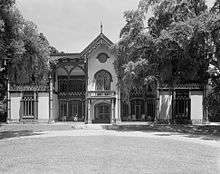 |
February 24, 1983 | St. Francisville | West Feliciana | House destroyed by fire in 1963. Gardens and ruins open daily 9:00 to 4:30, March 1 to June 30 & October 1 to December 1. |
| 91001046 | Aillet House |  |
August 9, 1991 | Port Allen | West Baton Rouge | Built in 1830; French-Creole Architecture |
| 01000007 | Albania Plantation House | 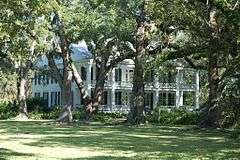 |
January 26, 2001 | Jeanerette | Iberia | |
| Albemarle Plantation House | Not applicable | Napoleonville | Assumption | Owned and in continuous operation by the original family since 1839. | ||
| 96001263 | Allendale Plantation | November 1, 1996 | Port Allen | West Baton Rouge | Owned by Henry Watkins Allen, the last Confederate Governor of Louisiana. Burned to the ground by Union troops in 1862. | |
| 82000469 | Ardoyne Plantation House | November 1, 1982 | Houma | Terrebonne | ||
| 80004476 | Arlington Plantation | October 3, 1980 | Lake Providence | East Carroll | ||
| 82000457 | Arlington Plantation House | October 5, 1982 | Franklin | St. Mary | ||
| 82004676 | Arlington Plantation House | August 11, 1982 | Washington | St. Landry | ||
| 79001050 | Ashland (Belle Helene) | .jpg) |
May 4, 1979 | Geismar | Ascension | |
| 72000552 | Asphodel Plantation and Cemetery | November 15, 1972 | Jackson | |||
| 87000729 | Audubon Plantation House | May 14, 1987 | Baton Rouge | East Baton Rouge | ||
| 82000434 | Avondale Plantation Home | December 17, 1982 | Clinton | East Feliciana | ||
| 07000424 | Bagatelle Plantation House | May 9, 2007 | Sunshine | Iberville | ||
| 79001056 | Battleground Plantation | May 14, 1979 | Sicily Island | Catahoula | ||
| 98001425 | Belle Alliance | November 23, 1998 | Donaldsonville | Assumption | Italianate and Greek Revival home, built about 1846. | |
| Belle Grove |  |
Not applicable | White Castle | Iberville | ||
| 79001083 | Bennett Plantation House | May 14, 1979 | Alexandria | Rapides | ||
| 91000705 | Bocage Plantation | June 20, 1991 | Darrow | Ascension | Built in 1837, possibly designed by James H. Dakin | |
| 83000527 | Bouverans Plantation House | July 21, 1983 | Lockport | |||
| 80001709 | Breston Plantation House | November 22, 1980 | Columbia | Caldwell | ||
| 83000503 | Buckmeadow Plantation House | September 15, 1983 | Lake Providence | East Carroll | ||
| 79001103 | Butler-Greenwood Plantation | 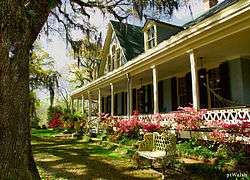 |
April 17, 1979 | St. Francisville | West Feliciana | |
| 82002754 | Calliham Plantation House | July 22, 1982 | Hamburg | |||
| 84002859 | Calumet Plantation House | October 18, 1984 | Patterson | St. Mary | ||
| 79001069 | Carter Plantation | February 23, 1979 | Springfield | Livingston | ||
| 82002757 | Cashpoint Plantation House | August 11, 1982 | Elm Grove | Bossier | ||
| 92000583 | Caspiana Plantation Store | June 5, 1992 | Natchitoches | |||
| 88001049 | Cedar Bend Plantation | July 14, 1988 | Natchez | |||
| 76000965 | Cedars Plantation | May 19, 1976 | Oak Ridge | |||
| 82000442 | Chatchie Plantation House | October 25, 1982 | Thibodaux | Lafourche | ||
| 73000869 | Cherokee Plantation | August 14, 1973 | Natchitoches | |||
| 77001519 | Chretien Point Plantation | May 26, 1977 | Sunset | St. Landry | ||
| 85000970 | Clarendon Plantation House | May 9, 1985 | Evergreen | Avoyelles | ||
| 75000857 | Cottage Plantation | March 17, 1975 | St. Francisville | West Feliciana | ||
| 84000144 | Crescent Plantation | October 18, 1984 | Tallulah | Madison | ||
| 73000868 | Darby Plantation | March 26, 1973 | New Iberia | |||
| 86001054 | Desire Plantation House | May 15, 1986 | Vacherie | St. James | Built circa 1835, French Creole perique tobacco plantation. Private. | |
| 73002132 | Destrehan Plantation |  |
March 20, 1973 | Destrehan | St. Charles | Completed in 1790, the site of one of three tribunals which tried and executed slaves after the 1811 German Coast Uprising, the largest slave rebellion in U.S. history; this occurred during the Orleans Territorial period, about 18 months before Louisiana statehood. The house and grounds have been restored by a nonprofit organization and are open to the public. |
| 87000851 | Dixie Plantation House | May 29, 1987 | Franklin | |||
| 85002759 | Ducros Plantation | November 7, 1985 | Schriever | Terrebonne | ||
| 94000742 | Dulcito Plantation House | July 22, 1994 | New Iberia | |||
| 82002791 | El Dorado Plantation House | March 24, 1982 | Livonia | Pointe Coupee | ||
| 88003135 | Emilie Plantation House | January 13, 1989 | Garyville | |||
| 75000848 | Enterprise Plantation | March 17, 1975 | Jeanerette | Iberia | ||
| 91001386 | Evergreen Plantation |  |
April 27, 1992 | Wallace 30°01′37″N 90°38′22″W / 30.02690°N 90.63958°W |
St. John the Baptist | Composed of 39 buildings, including a main house and slave quarters, Evergreen Plantation is an intact example of major plantation complexes found during the antebellum era of the Southern United States.[4][5] Open to visitors. |
| 88000102 | Fairhaven Plantation House | February 11, 1988 | Zachary | East Baton Rouge | ||
| 93000821 | Fairview Plantation House | August 12, 1993 | Ethel | East Feliciana | ||
| 10000062 | Felicity Plantation | March 8, 2010 | Vacherie | St. James | Sister plantation to St. Joseph Plantation, built circa 1850 and privately owned. | |
| Frogmore Plantation | Not applicable | Ferriday | Concordia | Established circa 1815, Frogmore has a steam-powered cotton gin. Plantation tour is a Rand-McNally "Must See Site" and in AAA's Southern Traveler magazine is one of the three favorite attractions in the tri-state area of Ark./La./Miss. | ||
| 82004674 | Frozard Plantation House | August 12, 1982 | Grand Coteau | St. Landry | ||
| 93001548 | Godchaux-Reserve Plantation House | January 21, 1994 | Reserve | St. John the Baptist | ||
| 97000967 | Gracelane Plantation House | August 29, 1997 | Baton Rouge | |||
| 92000510 | Graugnard Farms Plantation House | May 14, 1992 | St. James | |||
| 82000451 | Harlem Plantation House |  |
October 26, 1982 | Pointe à la Hache | Plaquemines | |
| 78001438 | Hazelwood Plantation |  |
July 31, 1978 | Laurel Hill | ||
| 86003129 | Homestead Plantation Complex | November 6, 1986 | Plaquemine | |||
| 70000842 | Homeplace Plantation House | .jpg) |
April 15, 1970 | Hahnville 29°58′16″N 90°24′27″W / 29.97105°N 90.40758°W |
St. Charles | Built circa 1790, large French Colonial raised cottage. Not open to the public. |
| 04001470 | Hope Plantation House | January 11, 2005 | Garyville | |||
| 80001694 | The Houmas |  |
September 27, 1980 | Burnside | Ascension | |
| 87002449 | Inglewood Plantation Historic District | January 14, 1988 | Alexandria | Rapides | ||
| 01000669 | Katie Plantation House | June 29, 2001 | Breaux Bridge | |||
| 06000317 | Kenilworth Plantation House | April 24, 2006 | St. Bernard | |||
| 71000362 | Kent Plantation House |  |
August 5, 1971 | Alexandria | Rapides | |
| 84000145 | LaBranche Plantation Dependency |  |
October 18, 1984 | St. Rose | St. Charles | |
| 02001296 | Landry Plantation House | November 8, 2002 | Youngsville | |||
| 93000322 | Lane Plantation House | April 22, 1993 | Ethel | |||
| 92001842 | Laura Plantation | 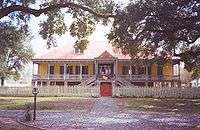 |
February 3, 1993 | Vacherie | St. James | Plantation heiress and manager Laura Lacoul Gore's (1861-1963) autobiography Memories of the Old Plantation Home: A Creole Family Album (Nov. 2000) tells the family's history and her experience living at the plantation. Open to the public. |
| 78001426 | Laurel Valley Sugar Plantation |  |
March 24, 1978 | Thibodaux | Lafourche | |
| 93000694 | LeBeuf Plantation House | July 29, 1993 | New Orleans | |||
| [Leonard Plantation also known as webert plantation] | Not applicable | algiers | Orleans | Established circa 1800's, located on Patterson and Merrill st., was built over 150 years ago. it extended from the river road to the woods about a mile and a half, and was noted for its very productive truck gardens. one of the largest plantations in this area, it was truly a showplace with its beautiful porches and landscaped gardens. ravaged by Hurricane Betsy in the 1965 it was dismantled several years later. | ||
| 94000705 | Linwood Plantation Manager's House | September 23, 1994 | Newellton | |||
| 79001057 | Lisburn Plantation House | July 26, 1979 | Ferriday | |||
| 74000924 | Live Oaks Plantation | November 20, 1974 | Rosedale | |||
| 80001748 | Logtown Plantation | October 16, 1980 | Monroe | |||
| 77000678 | Loyd Hall Plantation | April 29, 1977 | Cheneyville | Rapides | ||
| 02001603 | Lucky Plantation House | December 27, 2002 | Sunshine | Iberville | ||
| 73000860 | Madewood Plantation House | 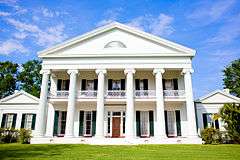 |
May 4, 1983 | Napoleonville 29°55′39″N 90°59′39″W / 29.92738°N 90.99426°W |
Assumption | |
| 83000548 | Magnolia Plantation | January 3, 1998 | Schriever 29°42′53″N 90°49′08″W / 29.714722°N 90.818889°W |
Terrebonne | ||
| 79001071 | Magnolia Plantation | .jpg) |
January 3, 2001 | Derry 31°33′11″N 92°56′33″W / 31.55294°N 92.94240°W |
Natchitoches | |
| 86000253 | Magnolia Lane | February 13, 1986 | Westwego | Jefferson | ||
| 72000549 | Magnolia Mound Plantation House |  |
September 7, 1972 | Baton Rouge | East Baton Rouge | |
| 87002135 | Marengo Plantation House | December 14, 1987 | Jonesville | |||
| 83000533 | Mary Plantation House | July 13, 1983 | Braithwaite | Plaquemines | ||
| 72000556 | Melrose Plantation | .jpg) |
May 30, 1974 | Melrose 31°05′16″N 92°58′03″W / 31.08771°N 92.96756°W |
Natchitoches | |
| 80001769 | Monte Vista Plantation House | June 9, 1980 | Port Allen | |||
| 87002505 | Montegut Plantation House | January 21, 1988 | LaPlace | |||
| 82000444 | Montrose Plantation House | October 5, 1982 | Tallulah | Madison | ||
| 82000468 | Moro Plantation House | October 5, 1982 | Waterproof | Tensas | ||
| 06000779 | Moss Grove Plantation House | September 6, 2006 | Jonesville | |||
| 76002167 | Moundville Plantation House | December 12, 1976 | Washington | |||
| 80001717 | Mount Hope Plantation House | 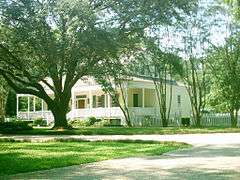 |
December 3, 1980 | Baton Rouge | East Baton Rouge | |
| 79001094 | Myrtle Grove Plantation | May 10, 1979 | Waterproof | Tensas | ||
| 74002185 | Myrtle Hill Plantation House | December 4, 1974 | Gloster | |||
| 78001439 | Myrtles Plantation |  |
September 6, 1978 | St. Francisville | West Feliciana | |
| 76000966 | Narcisse Prudhomme Plantation | July 13, 1976 | Natchitoches | |||
| 85000976 | Narrows Plantation House | May 9, 1985 | Lake Arthur | Jefferson Davis | ||
| 80001733 | Nottoway Plantation House |  |
June 6, 1980 | White Castle | Iberville | |
| 74002187 | Oak Alley Plantation |  |
December 2, 1974 | Vacherie 30°00′15″N 90°46′33″W / 30.00427°N 90.77593°W |
St. James |
|
| 92000036 | Oak Grove Plantation Dependencies | February 13, 1992 | St. Francisville | West Feliciana | ||
| 79001073 | Oakland Plantation |  |
January 3, 2001 | Natchez 31°39′54″N 93°00′12″W / 31.66500°N 93.00333°W |
Natchitoches | |
| 80001720 | Oakland Plantation House | October 3, 1980 | Gurley | East Feliciana | ||
| 73002162 | Oaklawn Manor | 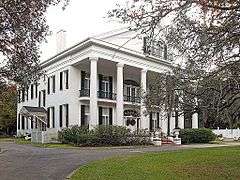 |
March 30, 1973 | Franklin | St. Mary | Plantation home of U.S. Senator Alexander Porter. |
| 79001072 | Oaklawn Plantation |  |
March 28, 1979 | Natchez | Natchitoches | |
| 73000878 | Oakley Plantation | January 25, 1973 | St. Francisville | West Feliciana | John James Audubon worked here as Eliza Pirrie's art tutor, for four months in 1821. He painted 32 of his famous Birds of America during that time. Audubon's wife Lucy also taught at Oakley. Open as the Audubon State Historic Site. | |
| 80001697 | Oakwold Plantation House | July 23, 1980 | Evergreen | |||
| 80001764 | Orange Grove Plantation House | March 26, 1980 | Houma | Terrebonne | Circa-1840 Greek Revival briquette-entre-poteaux architecture; operates as an inn today. See Orange Grove Plantation House. | |
| 90001748 | Ormond Plantation House | 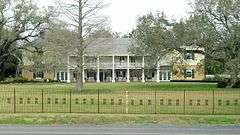 |
November 11, 1990 | Destrehan | St. Charles | |
| 77000665 | Palo Alto Plantation | April 13, 1977 | Donaldsonville | Ascension | ||
| 70000258 | Parlange Plantation | .jpg) |
May 30, 1974 | Mix 31°39′54″N 93°00′12″W / 31.66500°N 93.00333°W |
Pointe Coupee | |
| 03001064 | Pegram Plantation House | October 24, 2003 | Lecompte | Rapides | ||
| 71000360 | Pitot House |  |
September 28, 1971 | New Orleans | Orleans | Built in the late 18th century in what then was outside of the city, home to Mayor James Pitot in the early 19th century. House and grounds restored and open to the public. |
| 84001347 | Pleasant View Plantation House | April 5, 1984 | Oscar | Pointe Coupee | ||
| 80004251 | Judge Poché Plantation House | December 3, 1980 | Convent | St. James | ||
| 87002136 | Poplar Grove Plantation House | December 14, 1987 | Port Allen | West Baton Rouge | ||
| 01000943 | Residence Plantation House | September 8, 2001 | Houma | Terrebonne | ||
| 79001064 | Richland Plantation | March 28, 1979 | Norwood | East Feliciana | ||
| 80001736 | Rienzi Plantation House | 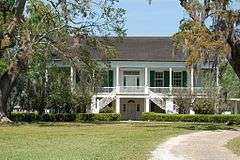 |
May 31, 1980 | Thibodaux | Lafourche | |
| 80001771 | Rosale Plantation | December 8, 1980 | St. Francisville | West Feliciana | ||
| 76000974 | Rosalie Plantation Sugar Mill | January 2, 1976 | Alexandria | Rapides | ||
| 73000880 | Rosebank Plantation House | April 13, 1973 | Weyanoke | |||
| 01000765 | Rosedown | .jpg) |
April 5, 2005 | St. Francisville 30°47′46″N 91°22′15″W / 30.79602°N 91.37095°W |
West Feliciana | |
| 99001039 | Sandbar Plantation House | September 2, 1999 | Port Allen | |||
| 74002186 | San Francisco Plantation House |  |
May 30, 1974 | Reserve 30°02′51″N 90°36′20″W / 30.04753°N 90.60554°W |
St. John the Baptist | |
| 78003448 | Santa Maria Plantation House | December 29, 1978 | Baton Rouge | |||
| 82000445 | Scottland Plantation House | November 2, 1982 | Tallulah | Madison | ||
| 86001495 | Sebastopol Plantation House | August 13, 1986 | St. Bernard | |||
| 72000553 | Shadows-on-the-Teche | .jpg) |
May 30, 1974 | New Iberia 30°00′09″N 91°48′54″W / 30.00254°N 91.81499°W |
Iberia | The Greek Revival home was completed in 1834 on the Bayou Teche by wealthy planters David and Mary Weeks, within the town of New Iberia. It remained in the Weeks family until 1958, when William Weeks Hall died and donated the building to the National Trust for Historic Preservation. Open for tours. |
| 95000387 | Smithfield Plantation House | April 7, 1995 | Port Allen | West Baton Rouge | ||
| 83000558 | Solitude Plantation House | January 27, 1983 | St. Francisville | West Feliciana | ||
| 74002188 | Southdown Plantation | January 18, 1974 | Houma | Terrebonne | ||
| 80001695 | St. Emma | June 30, 1980 | Donaldsonville | Assumption | Circa-1850 home on former sugar plantation, scene of a Civil War skirmish in 1862.[6] | |
| 82000470 | St. George Plantation House | 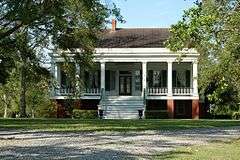 |
October 5, 1982 | Schriever | Terrebonne | |
| 05000987 | St. Joseph Plantation House | September 6, 2005 | Vacherie | St. James | Early 19th-century plantation, joined in 1890 with Felicity Plantation to form the St. Joseph Plantation & Manufacturing Company. Privately owned. | |
| 75000849 | St. Louis Plantation | December 3, 1975 | Plaquemine | Iberville | Antebellum home of Italianate and Greek Revival style, still located on a working sugar cane plantation; owned by the same family for over 150 years and named for the city in Missouri. Private. | |
| 79001104 | St. Maurice Plantation | April 3, 1979 | St. Maurice | Pointe Coupee | ||
| 03000680 | Star Hill Plantation Dependency | July 24, 2003 | Star Hill | |||
| 98000570 | Stephanie Plantation House | May 20, 1998 | Arnaudville | |||
| 82000432 | Synope Plantation House | October 5, 1982 | Columbia | |||
| 79001059 | Tacony Plantation House | April 19, 1979 | Vidalia | Concordia | ||
| 80001731 | Tally-Ho Plantation House | January 20, 1980 | Bayou Goula | Iberville | ||
| 99000257 | Trio Plantation House | February 26, 1999 | Rayville | |||
| Uncle Sam Plantation |  |
Not applicable | Convent | St. James | ||
| 02000297 | Valverda Plantation House | April 1, 2002 | Maringouin | Pointe Coupee | ||
| 77000677 | White Hall Plantation House | May 26, 1977 | Lettsworth | Pointe Coupee | ||
| 87001475 | Whitehall Plantation House | September 8, 1987 | Monroe | |||
| 92001566 | Whitney Plantation Historic District | November 24, 1992 | Wallace | St. John the Baptist | ||
| 88000977 | Wildwood Plantation House | June 30, 1988 | Jackson | |||
| 98000702 | Woodland Plantation |  |
June 18, 1998 | West Pointe à la Hache | Plaquemines |
Historical background of the plantation era
Upland or green seeded cotton was not a commercially important crop until the invention of an improved cotton gin in 1793. With an inexpensive cotton gin a man could remove seed from as much cotton in one day as a woman could de-seed in two months working at a rate of about one pound per day.[7] The newly mechanized cotton industry in England during the Industrial Revolution absorbed the tremendous supply of cheap cotton that became a major crop in the Southern U.S.
At the time of the cotton gin’s invention, the sub tropical soils in the Eastern U.S. were becoming depleted, and the fertilizer deposits of guano deposits of South America and the Pacific Islands along with the nitrate deposits in the Chilean deserts were not yet being exploited, meaning that there were fertilizer shortages, leading to a decline in agriculture in the Southeast and a westward expansion to new land.
Transportation at the time was extremely limited. There were almost no improved roads in the U.S. or in the Louisiana Territory and the first railroads were not built until the 1830s.[8] The only practical means for shipping agricultural products more than a few miles without exceeding their value was by water. This made much of the land in the U.S. unsuitable for growing crops other than for local consumption.
Under ownership of Spain, New Orleans held the strategically important location between the Mississippi River and Lake Pontchartrain. The Carondelet Canal, which was completed in 1794, connected the Tremé section of New Orleans with Bayou St. John, giving shipping access to Lake Pontchartrain as an alternative route to the Gulf of Mexico. The U.S. gained rights to use the New Orleans port in 1795. See: New Orleans#History
Louisiana (New Spain) was transferred by Spain to France in 1800, but it remained under Spanish administration until a few months before the Louisiana Purchase. The huge swath of territory purchased from Napoleon Bonaparte in 1803 was sparsely populated. During the Thomas Jefferson Presidency, a high priority was to build roads to New Orleans, specifically the Natchez Trace and the Federal Road through Georgia, initially intended to facilitate mail delivery.
The Napoleonic Wars and the Embargo Act of 1807 restricted European trade, which did not recover until the end of the War of 1812 in 1815. The Year without a summer of 1816 resulted in famine in Europe and a wave of immigration to the U.S., with New Orleans being the destination of many refugees. The return of good harvests in Europe along, with the newly cleared and planted land in the Midwest and Mississippi River Valley and improvements in transportation, resulted in a collapse in agricultural prices that caused the 1818-19 depression. Agricultural commodity prices remained depressed for many years, but their eventual recovery resulted in a new wave of land clearing, which in turn triggered another depression in the late 1830s. Cotton prices were particularly depressed.[9]
Until the development of the steamboat, transportation of goods on major rivers was generally accomplished either with barges or flatboats, floated downstream or pushed upstream with poles or by hand using overhanging tree limbs. On the Mississippi River, most shipping was down river on log rafts or wooden boats that were dismantled and sold as lumber in the vicinity of New Orleans. Steam-powered river navigation began in 1811-12, between Pittsburgh, Pennsylvania, and New Orleans. Inland steam navigation rapidly expanded in the following decades. Railroads appeared before the Civil War, though at first were used to link waterways. After the Civil War, railroads took over most of the hauling of goods.
It was during the period of expanding steam transportation that plantation agriculture dominated the Southern economy, with two-thirds of the millionaires in the U.S. living in Louisiana, mostly between Natchez, Mississippi, and New Orleans. The surviving plantation homes range from relatively modest dwellings to opulent mansions, some containing original furnishings and many with period furniture.
Due to poor transportation and slow industrialization, plantations tended to be somewhat self-sufficient, growing most of their own food, harvesting their own timber and firewood, repairing farm implements, and constructing their own buildings. Many slaves were skilled blacksmiths, masons, and carpenters who were often contracted out. Cloth, shoes, and clothing were imported from Europe and from the Northeast U.S.
The self-sufficiency of plantations and cheap slave labor hindered economic development of the South. Contemporary descriptions cite the lack of towns, commerce, and economic development.
Besides the necessity of river transportation, the goound near the rivers and old river channels contained the best agricultural land, where the sandy and silty soil settled, increasing the height of the natural levees. The clay soil settled farther away from the rivers and being less stable, it slumped to muddy back-swamps.[10] The plantations in the vicinity of St. Francisville, Louisiana, are on a high bluff on the east side of the Mississippi River with loess soil, which was not as fertile as the river alluvium, but was relatively well-suited to plantation agriculture.
Slave housing
Examples of slave housing can be found on many of the extant plantations.
Examples of slave housing at Laura and San Francisco plantations are wooden buildings with two or three separate rooms, including the kitchen, and furnished with one or more bedsteads and a few other pieces of furniture. These were intended to house a single family.
Contemporary accounts of slave housing described it as being better than that of many free white laborers in the U.S.[11]
See also
| Wikimedia Commons has media related to Plantations in Louisiana. |
- History of slavery in Louisiana
- History of Louisiana
- List of plantations in the United States
- Plantations in the American South
- Plantation complexes in the Southeastern United States
References
- ↑ "How to Apply the National Register Criteria for Evaluation," (PDF), National Register Bulletins, National Park Service. Retrieved March 22, 2007.
- ↑ National Park Service (April 2007). "National Historic Landmarks Survey: List of National Historic Landmarks by State" (PDF). Archived from the original (PDF) on 2007-06-09. Retrieved 2007-05-20.
- ↑ National Park Service. "National Historic Landmark Program: NHL Database". Retrieved 2007-08-14.
- ↑ "Evergreen Plantation". National Historic Landmarks Program. National Park Service. Retrieved 2010-02-18.
- ↑ "Evergreen Plantation". National Register of Historic Places Travel Itinerary. National Park Service. Retrieved 2010-02-18.
- ↑ Daspit, Fred (2006). Louisiana architecture, 1840-1860. University of Louisiana at Lafayette. p. 263. ISBN 9781887366748.
- ↑ Roe, Joseph Wickham (1916), English and American Tool Builders, New Haven, Connecticut: Yale University Press, p. 145, LCCN 16011753. Reprinted by McGraw-Hill, New York and London, 1926 (LCCN 27-24075); and by Lindsay Publications, Inc., Bradley, Illinois, (ISBN 978-0-917914-73-7).
- ↑ Taylor, George Rogers. The Transportation Revolution, 1815-1860. ISBN 978-0873321013.
- ↑ North, Douglas C. (1966). The Economic Growth of the United States 1790-1860. New York, London: W. W. Norton & Company. ISBN 978-0-393-00346-8.
- ↑ See soil surveys of the various parishes.
- ↑ Huston, James L (1986). The Panic of 1857 and the Coming of the Civil War. Baton Rouge, LA: LSU Press.